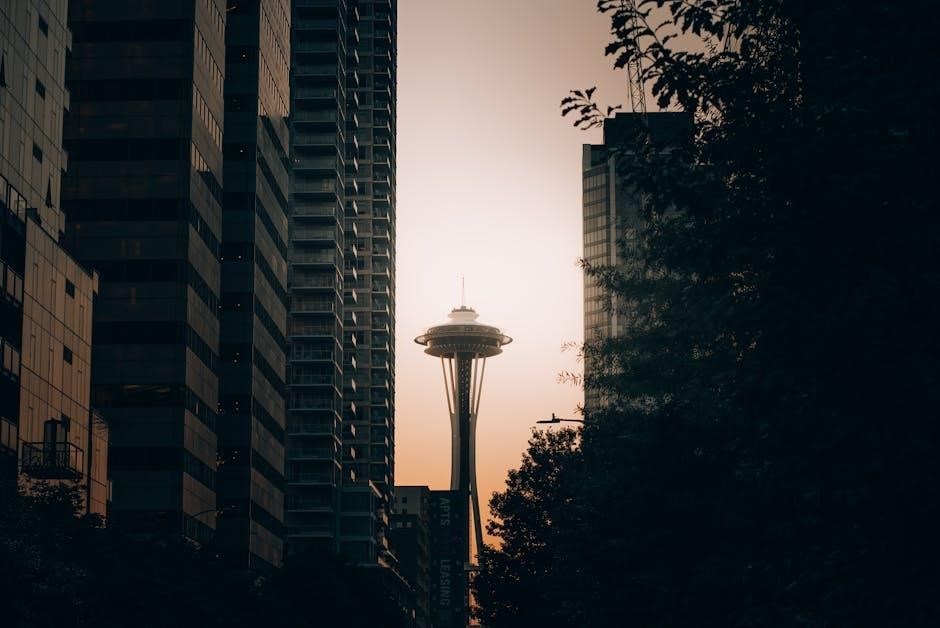The Seattle Stormwater Manual provides guidelines for managing stormwater runoff, ensuring compliance with local regulations. It emphasizes Low Impact Development (LID) practices and Green Stormwater Infrastructure (GSI) to mitigate environmental impacts effectively.
1.1 Overview of the Seattle Stormwater Manual
The Seattle Stormwater Manual is a comprehensive guide outlining requirements and best practices for managing stormwater runoff in Seattle. Updated in 2021, it replaces previous codes and rules, ensuring alignment with environmental regulations. Administered jointly by the Seattle Department of Construction and Inspections (SDCI) and Seattle Public Utilities (SPU), the manual provides detailed guidelines for developers, property owners, and designers. It emphasizes the use of Low Impact Development (LID) practices and Green Stormwater Infrastructure (GSI) to reduce runoff and improve water quality. The document includes design standards, rainfall data, and compliance requirements for projects with impervious surfaces exceeding 2,000 square feet. It also offers tools like calculators and design templates to facilitate implementation. The manual is structured to be user-friendly, with clear sections on hydrology, hydraulics, and BMPs, making it an essential resource for sustainable stormwater management in Seattle. Regular updates ensure it adapts to new technologies and regulatory changes.
1.2 Importance of Stormwater Management in Seattle
Stormwater management is critical in Seattle due to its unique climate and environmental challenges. The city receives an average of 37 inches of rainfall annually, making stormwater runoff a significant concern. Proper management prevents flooding, protects water quality, and safeguards aquatic ecosystems. Urban runoff carries pollutants like oil, sediment, and nutrients into waterways, harming salmon and other marine life. Effective stormwater systems also reduce erosion and protect infrastructure, ensuring public safety and property value. Seattle’s commitment to environmental sustainability makes stormwater management a priority, aligning with local and federal regulations. The city’s efforts aim to balance urban development with ecological preservation, ensuring a healthy environment for future generations. By addressing these challenges, Seattle sets a benchmark for innovative and sustainable stormwater solutions.

History and Evolution of the Seattle Stormwater Manual
The Seattle Stormwater Manual originated in the 1990s to address urban stormwater challenges. It has evolved through updates, including a major revision in 2018, integrating new technologies and regulatory requirements to enhance stormwater management practices in Seattle.
2.1 Development and Updates of the Manual
The Seattle Stormwater Manual was first developed in the late 1990s to provide guidance on managing stormwater in urban areas. Over the years, it has undergone significant updates to reflect advancements in stormwater management practices and changing environmental regulations. The manual was comprehensively revised in 2018 to incorporate Low Impact Development (LID) and Green Stormwater Infrastructure (GSI) practices, aligning with Seattle’s environmental goals. Updates are typically driven by new research, emerging technologies, and evolving regulatory requirements. The Seattle Public Utilities (SPU) collaborates with stakeholders, including developers, engineers, and environmental experts, to ensure the manual remains relevant and effective. Each update cycle includes public review and input to address community needs and improve stormwater management outcomes. The manual is now a cornerstone for sustainable urban drainage in Seattle, continually evolving to meet the city’s growing challenges.
2.2 Key Milestones in the Manual’s Evolution
The Seattle Stormwater Manual has undergone several key milestones since its inception. Initially introduced in 1999, it established foundational guidelines for stormwater management in Seattle. A major update in 2009 incorporated Low Impact Development (LID) practices, emphasizing sustainable stormwater solutions. In 2016, the manual was revised to align with updated municipal codes and environmental regulations. This version introduced Green Stormwater Infrastructure (GSI) as a priority, reflecting the city’s commitment to eco-friendly practices. Another significant milestone occurred in 2020, when the manual was updated to include stricter stormwater quality standards and enhanced design criteria. These updates ensure the manual remains a robust tool for addressing urban stormwater challenges. Each milestone reflects Seattle’s dedication to improving water quality and reducing environmental impacts. The manual’s evolution demonstrates a continuous commitment to innovation and sustainability in stormwater management. These key updates have solidified its role as a critical resource for developers, engineers, and policymakers.

Regulatory Framework Governing Stormwater Management in Seattle
The regulatory framework for stormwater management in Seattle is established by the Seattle Municipal Code and the Stormwater Management Manual, ensuring compliance with environmental standards and design criteria.
3.1 Seattle Stormwater Code and Manual
The Seattle Stormwater Code, part of the Seattle Municipal Code, sets legal requirements for stormwater management in the city. It mandates compliance with the Seattle Stormwater Management Manual, which provides detailed technical guidelines and standards for designing and implementing stormwater systems. The manual ensures that development projects align with environmental goals, such as reducing runoff, improving water quality, and protecting natural drainage systems. It emphasizes the use of Green Stormwater Infrastructure (GSI) and Low Impact Development (LID) practices, which mimic natural processes to manage rainwater effectively. The code and manual are regularly updated to reflect advancements in stormwater management, ensuring they remain effective tools for addressing urbanization impacts on water resources. Together, they establish a framework for sustainable stormwater management, balancing development needs with environmental protection.
3.2 Administration by SDCI and Seattle Public Utilities (SPU)
The Seattle Stormwater Manual is administered jointly by the Seattle Department of Construction and Inspections (SDCI) and Seattle Public Utilities (SPU). SDCI primarily oversees land use, development, and compliance with stormwater regulations, ensuring that projects meet the city’s environmental and safety standards. SPU, on the other hand, focuses on water quality, infrastructure, and the implementation of stormwater management systems. Together, these agencies ensure that the manual’s guidelines are effectively enforced and that stormwater management practices align with Seattle’s sustainability goals. SDCI reviews development plans for stormwater compliance, while SPU manages the city’s drainage systems and enforces water quality protections. Their collaborative efforts ensure a comprehensive approach to stormwater management, balancing regulatory enforcement with practical implementation to protect Seattle’s environment and public health. This partnership is essential for maintaining the city’s water infrastructure and achieving its environmental objectives.
3.3 Compliance Requirements for Developers and Property Owners
Developers and property owners in Seattle must adhere to specific compliance requirements outlined in the Stormwater Manual to ensure effective stormwater management. These requirements include implementing approved stormwater management systems, such as Low Impact Development (LID) practices and Green Stormwater Infrastructure (GSI), to reduce runoff and improve water quality. Projects must meet design standards, including rainfall rate data and hydraulic calculations, to ensure systems function correctly. Developers are also required to obtain necessary permits and undergo inspections to verify compliance with city codes. Property owners must maintain stormwater systems to prevent degradation and ensure long-term functionality. Failure to comply may result in fines or project delays. The manual provides detailed guidelines to help developers and property owners navigate these requirements, ensuring that stormwater management aligns with Seattle’s environmental goals and regulatory standards. Compliance is crucial for protecting local waterways and public health.

Stormwater Management Principles and Practices
Seattle’s stormwater management emphasizes sustainable practices, integrating green infrastructure and efficient drainage systems to protect water quality and reduce runoff impacts. These approaches align with environmental goals and community needs.
4.1 Low Impact Development (LID) Practices
Low Impact Development (LID) practices are central to Seattle’s stormwater management strategy, focusing on minimizing runoff and preserving natural hydrologic processes. These practices include permeable pavements, rain gardens, bioswales, and green roofs, which mimic natural drainage patterns. LID integrates land development with environmental protection by reducing impervious surfaces and filtering pollutants. Seattle encourages LID to manage stormwater at its source, reducing the burden on downstream infrastructure and improving water quality. The manual provides detailed design guidelines and implementation strategies for LID, ensuring compatibility with local regulations and climate conditions. By promoting LID, Seattle aims to create sustainable, eco-friendly urban environments while addressing the challenges of urbanization and climate change. These practices not only reduce stormwater runoff but also enhance biodiversity and community aesthetics, making them a cornerstone of the city’s stormwater management approach.
4.2 Green Stormwater Infrastructure (GSI)
Green Stormwater Infrastructure (GSI) plays a vital role in Seattle’s approach to stormwater management by integrating natural and engineered systems to capture, filter, and manage rainwater. GSI includes practices like rain gardens, green roofs, bioretention cells, and permeable pavements, which mimic natural drainage processes. These systems reduce stormwater runoff, improve water quality, and enhance urban biodiversity. Seattle’s Stormwater Manual provides detailed guidelines for designing and implementing GSI, ensuring they are effective in urban environments. GSI also offers co-benefits, such as mitigating urban heat islands and improving aesthetics. The city encourages GSI adoption through incentives and regulations, aligning with its commitment to sustainability and environmental resilience. By prioritizing GSI, Seattle aims to create a more livable and ecologically friendly city while addressing stormwater challenges effectively. These practices are integral to achieving the city’s long-term environmental goals.
4.3 Rainfall Rate Data and Design Considerations
The Seattle Stormwater Manual emphasizes the importance of accurate rainfall rate data for effective stormwater system design. It provides specific rainfall intensity tables based on Seattle’s climatic conditions, including 24-hour rainfall rates for various storm frequencies, such as 2-year, 10-year, and 100-year events. Designers are required to use these datasets to calculate runoff rates and ensure systems can handle extreme weather events. The manual also outlines considerations for drainage basin characteristics, such as impervious surfaces and terrain, which influence runoff behavior. It stresses the need to account for Seattle’s unique topography, including its hilly landscapes and variable soil types. By adhering to these guidelines, developers can design stormwater systems that mitigate flooding, erosion, and water quality issues. The manual’s rainfall data and design criteria ensure systems are resilient, aligning with Seattle’s goals for sustainable and environmentally responsible urban development. Proper application of these principles is critical for maintaining public safety and ecological health.

Design Considerations for Stormwater Systems
Stormwater system design must prioritize efficiency, reliability, and environmental impact. Considerations include drainage area, land use, soil types, and compliance with local regulations to ensure effective management of runoff and pollution mitigation.
5.1 Hydrology and Hydraulics in Stormwater Design
Hydrology and hydraulics form the foundation of stormwater design in Seattle, ensuring systems effectively manage runoff and mitigate flooding. Hydrologic analysis focuses on understanding precipitation patterns, runoff generation, and water flow dynamics. Hydraulic design involves sizing conveyance systems, such as pipes and channels, to handle peak flows while maintaining acceptable water quality. Engineers use rainfall intensity data, soil types, and land cover to estimate runoff rates and volumes. Tools like the Stormwater Management Manual and hydraulic modeling software (e.g., SWMM) aid in precise calculations. Designers must also account for Seattle’s unique topography, ensuring gravity-fed systems function efficiently. Accurate hydrologic and hydraulic assessments are critical to prevent erosion, protect infrastructure, and maintain aquatic habitats. Compliance with Seattle’s Stormwater Code ensures designs align with environmental and safety standards, safeguarding both urban and natural environments.
These principles guide the creation of resilient, sustainable stormwater systems tailored to Seattle’s climate and regulatory framework.

5.2 Best Management Practices (BMPs) for Stormwater
Best Management Practices (BMPs) for stormwater are essential strategies to reduce runoff pollution and manage stormwater effectively. These practices are designed to capture, treat, and infiltrate runoff at its source, mitigating the impact of urbanization on water quality. BMPs include both structural and non-structural measures, such as permeable pavements, rain gardens, green roofs, and bioswales. These systems mimic natural hydrologic processes, filtering pollutants and slowing down runoff to prevent erosion and flooding. BMPs also address water quality by removing sediments, nutrients, and other contaminants from stormwater before it enters waterways. In Seattle, BMPs are integrated into development projects to comply with the Stormwater Code and protect aquatic ecosystems.
By incorporating BMPs, developers and property owners can ensure sustainable stormwater management while meeting regulatory requirements, ultimately contributing to the health of Seattle’s environment and water resources.

5.3 Structural vs. Non-Structural Stormwater Management Methods
Stormwater management in Seattle employs both structural and non-structural methods to effectively address runoff. Structural methods involve physical infrastructure, such as detention ponds, bioswales, and green roofs, designed to capture, treat, and manage stormwater. These systems are engineered to handle specific flow rates and water quality goals. Non-structural methods, on the other hand, focus on practices that reduce runoff at its source, such as minimizing impervious surfaces, implementing low-impact development techniques, and promoting public education. Non-structural approaches often emphasize prevention and rely on natural processes to manage stormwater. Both methods are used in combination to achieve compliance with the Seattle Stormwater Manual and protect water quality. Structural methods provide tangible solutions, while non-structural practices address the root causes of stormwater issues, ensuring a comprehensive approach to urban drainage challenges.

Public Education and Community Engagement
Public education and community engagement are crucial for effective stormwater management. Outreach programs inform residents about stormwater impacts, while community involvement fosters collaboration in implementing solutions to protect Seattle’s water quality and environment.
6.1 Outreach Programs for Stormwater Management
Outreach programs play a vital role in educating the public about stormwater management in Seattle. These initiatives aim to raise awareness about the impact of stormwater runoff on water quality and the environment. The Seattle Stormwater Manual emphasizes the importance of engaging residents, businesses, and schools through workshops, seminars, and community events. Digital platforms, such as websites and social media, are also utilized to share resources and tips on stormwater best practices. Additionally, collaborative efforts with local organizations and nonprofits help amplify the reach of these programs. By fostering a sense of responsibility, outreach efforts encourage individuals to adopt practices that reduce pollution and protect Seattle’s waterways. These programs are designed to empower the community, ensuring that everyone contributes to sustainable stormwater management. Regular updates and feedback mechanisms further enhance the effectiveness of these outreach initiatives.
6.2 Community Involvement in Stormwater Projects
Community involvement is a cornerstone of effective stormwater management in Seattle. The Seattle Stormwater Manual encourages active participation from residents, businesses, and community groups in planning and implementing stormwater projects. Public meetings, neighborhood workshops, and online engagement platforms provide opportunities for stakeholders to share ideas and priorities. Volunteer programs, such as Adopt-A-Street or Stormwater Stewards, empower individuals to take direct action in maintaining local water quality. Collaborative efforts with schools and community organizations further foster education and involvement. By engaging the community, Seattle ensures that stormwater projects reflect local needs and priorities, leading to more inclusive and sustainable outcomes. This participatory approach not only strengthens community ownership but also enhances the effectiveness of stormwater management strategies. Regular updates and feedback mechanisms ensure that the public remains informed and involved throughout the project lifecycle.

Case Studies and Success Stories
Seattle’s Stormwater Manual showcases real-world applications through case studies and success stories, highlighting innovative, sustainable, and community-driven stormwater management projects that protect water quality and public health effectively.
7.1 The Bullitt Center: A Model for Stormwater Management
The Bullitt Center, located in Seattle, is renowned as one of the greenest commercial buildings in the world and serves as a prime example of effective stormwater management. Designed to meet the Living Building Challenge, the center incorporates advanced stormwater strategies that align with the Seattle Stormwater Manual’s principles. Its green roof, rainwater harvesting system, and bioretention swales work together to manage 100% of the site’s stormwater runoff, ensuring no discharge into the city’s sewer system. The building’s design prioritizes low-impact development (LID) and green stormwater infrastructure (GSI), demonstrating how urban development can coexist with environmental sustainability. By integrating innovative technologies and best practices, the Bullitt Center not only adheres to local regulations but also sets a benchmark for future projects. This case study highlights the effectiveness of holistic stormwater management and its role in protecting Seattle’s water quality and ecosystems.
7.2 Ship Canal Water Quality Project: A Major Stormwater Initiative
The Ship Canal Water Quality Project is a landmark stormwater management initiative in Seattle, aimed at improving water quality and reducing pollution in the Lake Washington Ship Canal and its surrounding waterways. This project aligns with the Seattle Stormwater Manual’s objectives by implementing green infrastructure and innovative stormwater management practices. It focuses on reducing combined sewer overflows (CSOs) and stormwater runoff pollutants through the use of rain gardens, permeable pavements, and bioswales. The project also emphasizes community engagement and education, fostering collaboration between residents, businesses, and local government. By integrating ecological restoration and advanced engineering, the Ship Canal Water Quality Project sets a precedent for large-scale stormwater management in urban environments. Its success highlights the importance of proactive measures to protect Seattle’s waterways and promote a sustainable future for the region’s ecosystems and communities.

Future Directions and Updates
The Seattle Stormwater Manual will continue to evolve, incorporating new technologies and regulatory changes. Future updates will focus on advancing green infrastructure, enhancing resilience to climate change, and improving design standards.
8.1 Adaptation to New Regulations and Technologies
The Seattle Stormwater Manual is expected to adapt to emerging regulations and technological advancements, ensuring compliance with updated environmental standards. As climate change intensifies, the manual will incorporate new strategies to address increased rainfall and sea-level rise.
Technological innovations, such as smart stormwater systems and advanced green infrastructure, will be integrated to improve efficiency. The manual will also emphasize data-driven approaches, leveraging real-time monitoring and predictive modeling to enhance stormwater design.
Collaboration with research institutions and industry experts will play a key role in identifying best practices. By staying ahead of regulatory changes and embracing innovation, the manual will continue to serve as a comprehensive guide for sustainable stormwater management in Seattle.
8.2 Continuous Improvement of the Stormwater Manual
The Seattle Stormwater Manual undergoes regular updates to reflect evolving best practices, public feedback, and emerging research. This ensures the document remains a trusted resource for effective stormwater management.
Public input is a cornerstone of the manual’s improvement process. Stakeholders, including developers, engineers, and environmental groups, contribute insights to enhance clarity and applicability. Additionally, the City of Seattle conducts periodic reviews to identify areas for refinement.
Research and development initiatives are integral to the manual’s evolution. New data on stormwater trends, innovative technologies, and lessons from completed projects are incorporated to maintain its relevance. Training programs and updated resources are also provided to help users adapt to changes.
This iterative approach ensures the manual remains a dynamic and reliable tool, supporting Seattle’s commitment to sustainable stormwater management and environmental stewardship.


